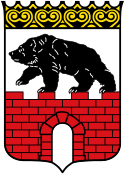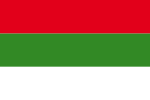Free State of Anhalt
| coat of arms | flag |
|---|---|

|

|
| Situation in the German Reich | |

|
|
| Arose from | Duchy of Anhalt |
| Today (part of): | Saxony-Anhalt |
| Data from 1925 | |
| State capital | Dessau |
| Form of government | republic |
| Head of state | Prime Minister |
| Constitution | Constitution of July 18, 1919 |
| Consist | 1918-1945 |
| surface | 2314 km² |
| Residents | 351.045 |
| Population density | 152 inhabitants per km² |
| Religions | 91.4% Ev. 4.0% Roman Catholic 0.1% other Christians 0.3% Jews 4.2% others |
| anthem | Anhalt song |
| Reichsrat | 1 vote |
| License Plate | A. |
| administration | 5 (from 1932: 4) circles |
| map | |

|
|
The Free State of Anhalt , from 1934 Land Anhalt , existed from 1918 to 1945 as a Land of the German Empire . It was the successor to the Duchy of Anhalt in the German Empire . In 1945 the state of Anhalt with parts of Braunschweig and Thuringia was attached to the Prussian province of Saxony , from 1947 this formed the new state of Saxony-Anhalt .
development
On November 12, 1918, the Duchy of Anhalt became a republic, as Prince Regent Aribert von Anhalt renounced the throne after street demonstrations in the name of the underage Duke Joachim Ernst von Anhalt and the entire Anhalt Princely Family. The abdication followed the formation of a workers 'and soldiers' council in Dessau under the chairmanship of Mayor Fritz Hesse on November 9, 1918. On November 14, a provisional government of the SPD and DDP was formed under the leadership of Wolfgang Heine (SPD).
In the election for the constituent (= constitutional) state assembly on December 15, 1918, the SPD received an absolute majority (58.03%) of the votes, but continued the coalition with the DDP. The constitution for Anhalt drawn up by the state assembly was passed on July 18, 1919.
In the state elections on April 24, 1932, the NSDAP was the strongest parliamentary group with 15 seats (six were from Dessau). With the help of civil rights, Alfred Freyberg (NSDAP) was elected Prime Minister of a NSDAP / DNVP coalition on May 21 . Freyberg was the first National Socialist Prime Minister in Germany. Under the National Socialist tyranny, the Bauhaus in Dessau , among others, had to stop teaching.
De facto, all territorial states of the German Reich already lost their independence with the provisional law for the alignment of the states with the Reich of March 31, 1933. With the law on the rebuilding of the Reich of January 30, 1934, the sovereign rights of all German states were transferred to the Reich . The Free State of Anhalt, which had existed since 1918, became the State of Anhalt.
After the Second World War , Anhalt lost its independence and was merged with the former Prussian Province of Saxony on October 20, 1946 to form the Province of Saxony-Anhalt .
After German reunification , the district reform in 1994 led to the establishment of the Anhalt-Zerbst district within the state of Saxony-Anhalt , so that the historical name "Anhalt" lived on not only in the state name, but also in a district name; In a recent district reform , this area was added to the newly formed district of Anhalt-Bitterfeld on July 1, 2007 , whereby Anhalt lives on as part of this new district name (although parts of the district, such as Bitterfeld, never belonged to the historical Anhalt). The area of the Evangelical Church of Anhalt still corresponds to the former Duchy or Free State of Anhalt.
politics
Parliament
The Landtag of the Free State of Anhalt had its seat in Dessau. The first session was on February 20, 1919. The legislative periods lasted four years from 1923, before only three years. The electoral system was proportional representation , but with closed lists. The Hare-Niemeyer method was used as the calculation method . The country had a vote in the Reichsrat .
Prime Minister
The Presidents of the Council of State 1918–1922 or Prime Ministers of the Free State of Anhalt 1922–1933 and State of Anhalt 1933–1945:
- November 14, 1918 to July 23, 1919: Wolfgang Heine , SPD
- July 23, 1919 to July 9, 1924: Heinrich Deist , SPD
- July 9, 1924 to November 25, 1924: Willy Knorr , DNVP
- November 25, 1924 to May 21, 1932: Heinrich Deist (2nd term of office)
- May 21, 1932 to January 8, 1940: Alfred Freyberg , NSDAP
- January 8, 1940 to April 1945: Rudolf Jordan , NSDAP
Reich Governor
With the provisional law for the alignment of the states with the Reich , the states lost their sovereignty and the following Reich governors were appointed for Anhalt and Braunschweig , based in Dessau:
- May 6, 1933 to October 23, 1935: Wilhelm Loeper
- November 1935 to April 20, 1937: Fritz Sauckel
- April 20, 1937 to April 1945: Rudolf Jordan
Demographics
In 1925 the Free State had 351,045 inhabitants on an area of 2299 km². In 1939 there were 436,213 inhabitants and an area of 2314 km².
Territorial division
- Cities: Ballenstedt , Gernrode , Gröbzig , Güntersberge , Harzgerode , Hoym
Bernburg (Saale) , Güsten , Hecklingen , Leopoldshall , Nienburg , Sandersleben
Dessau , Radegast , Raguhn , Roßlau , Köthen , Zerbst , Coswig - Exclaves: Großalsleben , Groß- and Klein- Mühlingen , Dornburg , Tilkerode
- Prussian enclaves: Löbnitz an der Linde , Repau , Pösigk , Schierau with Priorau and Möst
In 1942 the Prussian communities of Löbnitz ad Linde, Repau, Pösigk, Schierau, Priorau, Möst and Goltewitz were incorporated into the state of Anhalt and the communities of Tilkerode, Unterwiederstedt and Wadendorf were spun off into the province of Saxony in the state of Prussia.
Administrative division
Anhalt 1918–1945:
- Bernburg district ( since 1933 )
- City of Dessau ( since 1933 )
- City district of Koethen
- Zerbst district ( since 1935 )
- Ballenstedt district
- District of Bernburg
-
Dessau-Köthen district ( since 1932 )
- Dessau district ( until 1932 )
- District of Köthen ( until 1932 )
- Zerbst district
literature
- Walther Eggert: Anhalt Mosaic: Landscape and cultural images from the former state of Anhalt. Weidlich, Frankfurt am Main 1971 ISBN 3-8035-0555-0
- Johannes Jansson: The Principality of Anhalt and the Archdiocese of Magdeburg - 1647. (Historical map: Principatus Anhaldinus et Magdeburgensis Archiepiscopatu) Reprint, Rockstuhl, Bad Langensalza 2003, ISBN 3-932554-92-2
- Wilhelm van Kempen: Palaces and manors in the province of Saxony and in Anhalt. Weidlich, Frankfurt am Main 1961
- Norbert Michels (Ed.): Anhalt in old views: landscape, architecture, living worlds. Mitteldeutscher Verlag, Halle 2006. ISBN 3-89812-350-2
- Ralf Regener: The Free State of Anhalt in the early years of the Weimar Republic , in: Revolutionary times between the Saale and Elbe. Today's Saxony-Anhalt in the early years of the Weimar Republic, ed. v. Patrick Wagner and Manfred Hettling, Halle (Saale) 2019, pp. 47–68.
- Ralf Regener: "And now the old, rotten oak fell" The end of Ascanian rule in Anhalt , in: The end of the monarchy in the small German states. Prehistory, event and aftermath in politics and constitutional law 1914–1939, ed. v. Stefan Gerber, Vienna / Cologne / Weimar 2018, pp. 161–179.
- Ralf Regener: The fall of the Ascanians in Anhalt in 1918. Conditions, course and aftermath of the fall of a small German monarchy , Dessau-Roßlau 2013.
- Reinhold Specht : Bibliography on the history of Anhalt. 1930/3
- Johannes Wütschke:
- On the territorial development of Anhalt. In: Anhaltische Geschichtsblätter 13 (1937)
- Territorial development of Anhalt. (Atlas of the Saale and central Elbe region) 1958
Web links
Individual evidence
- ↑ www.verfassungen.de: Constitution for Anhalt of July 18, 1919
- ↑ Ralf Regener: The fall of the Askanians in 1918 in Anhalt. Conditions, course and aftermath of the fall of a small German monarchy , Dessau-Roßlau 2013, pp. 63–90.
- ↑ table
- ↑ The Constitution for Anhalt (full text)
- ↑ Table: Elections to the 6th Landtag
- ↑ The Free State of Anhalt. Events 1918–1933 (chronology)
- ↑ after the state elections on June 22nd ( table )
- ↑ after the state elections on April 24, 1932 ( table )
